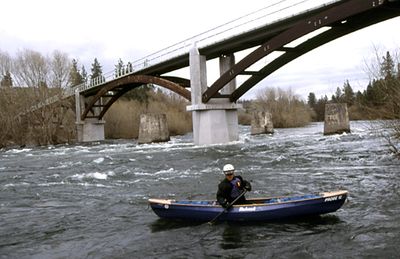White-water park in the works
Project plans to be presented at public meeting

Members of the public will get their chance to comment on a proposal to build a white-water park in and along the Spokane River west of downtown during a community meeting next Thursday at 6 p.m. at the West Central Community Center, 1603 N. Belt St.
The city Parks Department and members of the Friends of the Falls organization are seeking permits to construct an artificial rapid on a portion of the river channel adjacent at High Bridge Park. The white-water features would go below a trail crossing over the river.
Plans for the project will be showcased at next week’s meeting, which is a preliminary step to seeking a conditional use permit for shoreline development.
“We’d obviously like to have everyone come and tell us what they think,” said Steve Faust, executive director of the Friends organization.
Nearly $1.2 million in grants and donations have been raised, and a nationally renowned expert in designing white-water parks has been hired to develop the plan.
About 60 white-water parks have been built around the country, and based on the experience in other cities, Spokane could gain up to $2 million annually in increased spending by visitors because the parks are big draws for tourists. White-water sports have been gaining popularity.
A plan from Recreational Engineering and Planning in Boulder, Colo., calls for two u-shaped structures to be buried into the river channel to create artificial waves. Rock being stockpiled at the city’s wastewater treatment plant would be available for the construction.
Environmental concerns about the ability of trout and other fish to pass through the structures has led to a change in the plan, Faust said.
The man-made structures will cover about 60 percent of the river’s width with the remaining 40 percent being left in its natural state to allow fish passage, Faust said.
Existing concrete pillars left from the Union Pacific Railroad’s “high bridge” trestle over the river at High Bridge Park will be demolished down to the bed of the river. The bridge had served a UP yard on the north bank and a defunct rail line into a depot at what is now Riverfront Park.
Work on the white-water park is expected next summer when water flows are low and fish are not spawning.
Throughout the planning, sponsors of the project have consulted with regulatory agencies, river users, neighbors and tribal officials.
A cultural resources survey to examine Native American use of the site has just gotten started, Faust said. The area was a well known camp site and trading center for Spokane tribal ancestors, according to a previous archaeological study at the camp area in High Bridge Park.
Human habitation dates back at least 8,000 years, archaeologists have found.
The white-water features will be accompanied by stream-side improvements, including trail access to the river, parking, picnic area and restrooms. Bank stabilization and native vegetation will also be in the project.
Faust said the project seeks to retain the natural look of the river and will offer enhancements to the existing stream bank. Willow trees lining the north bank of the river will remain untouched, he said.